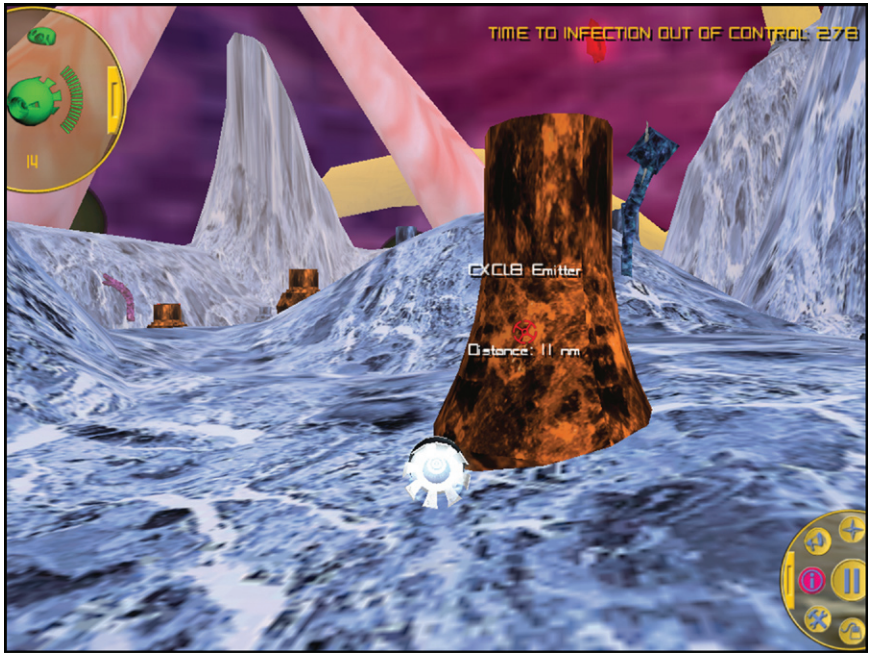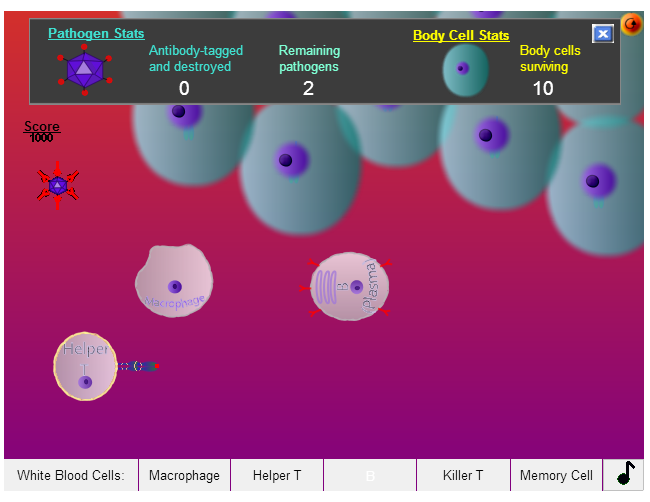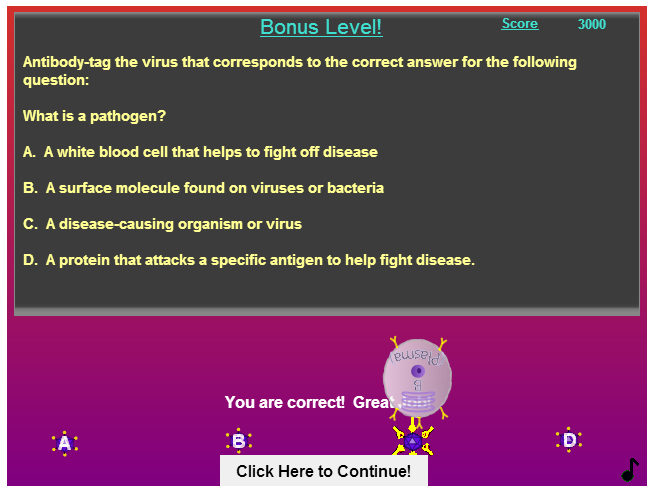Immune Attack is free downloadable game for Windows XP and later versions.
A number of very large institutions were involved with the game. It was funded chiefly by the National Science Foundation and developed over four years by the Federation of American Scientists, the University of South California, Brown University, and Escape Hatch Entertainment.
Garry M. Gaber (ex-LucasArts director of several Star Wars games) seems to have been the main creative force. It is also interesting to note that Jenova Chen of Journey fame is credited as one of the designers.
What does it teach?
You are introduced to various features of the innate immune system. The game is designed to appeal to mid school and high schools students but covers material that is normally taught in college.
What do you do?
Considering the Star Wars heritage, the game unsurprisingly joins the rank of biology games that borrows its concept from seminal sci-fi classic The Fantastic Voyage (1966). You pilot a miniature ship (a nanobot) through a 3D word of blood vessels and connective tissue on your mission to repair a defective immune system. You will mainly be teaching macrophages and neutrophils how to hunt and kill bacteria.
The mission is partitioned into discrete levels, for example:
- Find the monocyte in the blood vessels (just follow the map while “flying” in tunnels of blood)
- Make the monocyte transmigrate by activating cell adhesion molecules (“shoot” the selectins and an ICAM).
- Make a trail of complement proteins to guide the macrophage to the site of infection (“shoot” the C3a molecules)
Do you learn anything?
The levels are introduced by tutorials in the form of scientists and military styled officers who hand out objectives, information and advice. This is really were most of the learning is taking place, but during the levels themselves there is also information represented in a more concrete manner: scanning the organs and cells with your reticle displays an information box with text and a picture. This is quite neat.
The gameplay is less congenial to learning. The mechanics are identical to any space flight game: move around in a 3D environment, find things and shoot them. You don’t have to master the science to master the game, but you will certainly have to master the rather complicated controls and possess decent visuospatial skills to navigate the claustrophobic and confusing environments successfully. So the core of the game is as gamey as games get.
And yet there is not much depth to the game. Immune Attack is an exceptionally ambitious and big budget educational game, but it offers less of a simulation than a small amateur game like Conflict: Immunity. The levels are linear and straightforward. You don’t have to think; you don’t have to adapt to an evolving environment. You know what to do, but may not be quick and precise enough to do so. The challenge is physical, not cerebral.
Though the levels can be considered big minigames, they still offer a lot more than the game & watch-like simplicity of the minigames in Code Fred. Some are even quite engrossing – for a while. I initially enjoyed hunting bacteria in the connective tissue, which felt wonderfully organic and messy, but I rapidly got increasingly bored and frustrated as the task got out of hand and transformed into a Sisyphean game of Where’s Waldo. The more bacteria the macrophages engulfed, the harder it got to find the few remaining ones. At the same time they kept reproducing and put you back in square one. Thank god for the cheat code.
The game is in essence an interactive tutorial interspersed with spatial agility tests that you must pass before proceeding. The tests don’t have anything to do with understanding the (surprisingly advanced) biology but they might make some of the stuff more tangible and concrete. Flying around, trying to locate and shoot the selectins, and then watching the trailing monocyte attach and slow down, does hammer the process of transmigration into your head. It is, however, not a time efficient way of learning. I think it could work as a complement to textbooks and the developers indeed state that the game is “a supplemental teaching tool”.
Pros
Crammed full of facts and credible science in carefully crafted 3D-environments that evoke a sense of wonder.
Cons
Clichéd gameplay with superficial relevance to the scientific concepts.
Additional information



